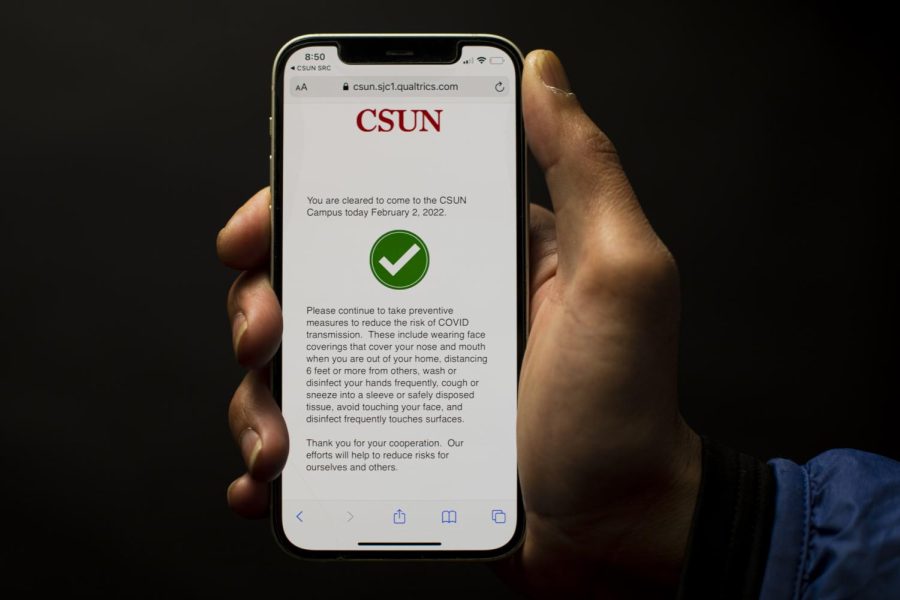Student health screening surveys explained
Photo Illustration by Taylor Arthur.
February 9, 2022
Over the course of the pandemic, CSUN has enacted health and safety guidelines in an effort to reduce the spread of COVID-19.
The return to in-person classes in 2021 led to CSUN implementing a required daily self-screening survey to prevent any outbreaks on campus.
“Students who come to campus are required to complete the online daily health screening for students through the CSUN app or student portal before coming to campus for any purpose including entry and on-going testing, to attend a class, appointment, service, or to participate in an on- or off-campus program or activity,” says the Matadors Forward website in the section titled “Daily Health Screening.”
The use of daily health screenings applies “to all students whether vaccinated or unvaccinated.”
CSUN student Aron Platz, a senior majoring in liberal studies, attests to using the self-screening survey on a daily basis. Platz frequently visits the Student Recreation Center.
“I do not feel it’s that effective because you can just click ‘no.’ It counts on personal accountability, which is the same thing as telling people not to come if they are sick,” Platz said. “I get why they do it — for liability reasons. I understand it, but I don’t think the effectiveness is that great.”
On CSUN’s health and safety department page there are quarantine protocols outlined for students and faculty if they test positive for COVID-19.
Zeina Otaky Ramirez, assistant dean of students and director of student conduct and ethical development, is one of the people in charge of examining the data from the health surveys, and observing whether or not students are following procedures.
Working alongside Ramirez is Helen Heinrich, director of data and analytics. Heinrich gives insight into the data collection process and what is done with the information provided in the health screening forms.
“When students push the button all that information goes on the background in sort of like a collector — like a database in order to digest that data,” Heinrich said. “[The data] is being used for monitoring.”
Heinrich says she is able to visualize any necessary steps to take from what she gathers from the surveys.
While the health self-screening surveys cannot prevent the spread of COVID-19, it is only a piece of a greater puzzle in combating the coronavirus, Ramirez notes.
“From my space of looking at student compliance I can see if there is an uptick of students who are not complying with the student health surveys,” Ramirez said. “As you know the health clearance survey is connected to every individual, whether it’s an employee or student ID, and that’s how we are able to look at that data.”
Once the self-screening surveys are sent, they are collected through a software called Qualtrax, which maintains and organizes the data. Kristina de la Vega, associate vice president of human resources, and CSUN’s information technology security team work together to preserve the database and help form reports from the surveys.
De la Vega also addresses what is to be expected from faculty and staff.
“Employees are to share their clearance with their manager. Managers have been instructed that they have a clearance from every employee coming to campus,” de la Vega said. “That’s a way to help ensure that there is compliance around employees completing it every time they come to campus.”
De la Vega and her team look at patterns and trends from the health surveys that could see how many employees are working on that particular day, who may be sick, and who may be on a leave of absence.
When there are positive case health forms among faculty and staff who were on campus the day before, Environmental Health and Safety Director Daniel Castellon and human resources have to file a report to the California Division of Occupational Safety and Health. That report includes the positive case, what building the employee was in, and the average number of employees who were in the same building within the last 14 days.
Castellon notes that the self-screening survey helps in second-guessing one’s health before stepping foot onto campus.
“I remember before Covid, I would not feel one hundred percent, but … ‘I’ll muscle through it.’ It was like ‘I have a small little headache, no big deal[,]’” Castellon said. “But now you have to think about it. You have to double-check.”
As of the spring 2022 semester, both students and faculty are still required to complete the health screening survey before arriving on campus.
